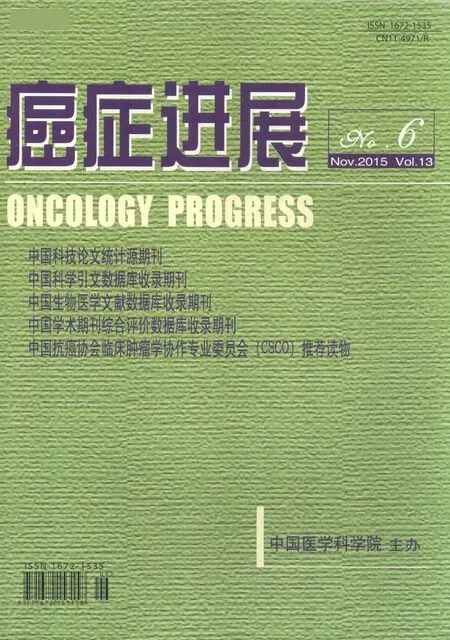阿瑞匹坦联合托烷司琼/皮质激素预防含顺铂化疗相关呕吐的临床观察
邢镨元 李峻岭
北京协和医学院中国医学科学院肿瘤医院内科,北京100021
阿瑞匹坦联合托烷司琼/皮质激素预防含顺铂化疗相关呕吐的临床观察
邢镨元 李峻岭#
北京协和医学院中国医学科学院肿瘤医院内科,北京100021
目的观察阿瑞匹坦联合托烷司琼/皮质激素预防含顺铂化疗引起呕吐的临床疗效及不良反应。方法选取一线使用阿瑞匹坦联合托烷司琼/皮质激素预防含顺铂化疗引起呕吐的初治肺癌患者43例,观察单周期、多周期化疗中急性和延迟性呕吐完全缓解率,完全控制率及不良反应。结果43例患者均完成含顺铂的相同方案2个周期,其中31例患者完成4个周期的疗效观察。治疗第1周期的总体观察期CR率为72.1%,CC率为65.1%;急性期CR率86.0%,延迟期CR率79.1%。连续4个周期化疗的患者中,总观察期CR率依次为74.2%、64.5%、54.8%、48.4%。不良反应主要表现为食欲缺乏、乏力、便秘、失眠、呃逆等,均为0/Ⅰ级。结论阿瑞匹坦联合托烷司琼/皮质激素预防含顺铂化疗引起的急性呕吐及延迟性呕吐均有很好的疗效,并且耐受性良好。
阿瑞匹坦;托烷司琼;顺铂;化疗;呕吐
Oncol Prog,2015,13(6)
恶心呕吐是化疗所致不良反应中发生率最 高,也是最影响患者治疗耐受性的因素之一。70%~80%接受化疗的患者会出现不同程度的恶心呕吐[1]。对于恶心呕吐的处理不当,可导致患者生活质量下降,电解质紊乱、营养失调,治疗依从性差,严重时自行中断抗肿瘤治疗等不良后果。阿瑞匹坦是首个上市的神经激肽-1(NK-1)受体拮抗剂,与P物质竞争结合NK-1受体,阻滞P物质兴奋NK-1受体从而减少呕吐的发生[2]。本研究选取43例采用高致吐化疗药物——顺铂一线治疗过程中,使用阿瑞匹坦联合托烷司琼/皮质激素治疗恶心呕吐(chemotherapy-induced nausea and vomiting,CINV)的肺癌患者,观察其临床疗效及不良反应的发生情况。
1 资料与方法
1.1 临床资料
选取中国医学科学院肿瘤医院内科自2013年9月至2014年1月入组的43例初治肺癌一线采用含顺铂方案化疗的患者。全部患者均有明确的病理诊断,年龄≥18周岁,ECOG评分<2分,预期能够完成至少2个周期相同方案的化疗,并且能够合作观察和记录不良反应。脑转移、肠梗阻、电解质紊乱等其他原因引起的恶心呕吐除外;化疗前72 h内无恶心呕吐,并未使用过止吐药物;排除长期需要使用皮质激素药物治疗的患者。入组患者中有男性21例,女性22例。年龄范围37~65岁,中位年龄50岁。既往患晕动症者2例,妊娠期呕吐10例,饮酒史15例。非小细胞肺癌32例,小细胞肺癌11例,详见表1。
1.2 治疗方案
1.2.1化疗方案 根据病种及分期不同,采用不同化疗方案。采用培美曲赛+顺铂方案化疗16例,紫杉醇+顺铂方案7例,吉西他滨+顺铂方案7例,多西他赛+顺铂方案2例,依托泊苷+顺铂方案11例(表1)。化疗药物根据常规推荐标准剂量给药:顺铂75 mg/m2,培美曲赛500 mg/m2,紫杉醇175mg/m2,吉西他滨1.0 mg/m(2第1、8天),依托泊苷120mg/m(2第1~3天)。
1.2.2止吐药物治疗 阿瑞匹坦胶囊:第1天(顺铂前1 h)125mg口服,第2~3天改为80mg口服。托烷司琼:第1~3天化疗前30 m in,5 mg静脉滴注,1次/天。地塞米松:第1天10mg静脉滴注,第2~4天3.75 mg口服,2次/天。另外在含培美曲赛、紫杉醇、多西他赛的化疗方案中,除预处理中地塞米松的使用外,不再额外给予皮质激素。
1.3 疗效及不良反应评价
根据2003年美国国立癌症研究所通用不良事件术语标准(NCI-CTCAE)3.0版进行评估[3],记录化疗第1~5天呕吐的次数、是否使用挽救药物治疗,以及记录化疗后出现的一切不良反应。完全缓解(CR):无呕吐,且未使用任何解救治疗;部分缓解(PR):轻微呕吐1~2次/天;轻度缓解(MR):呕吐3~5次/天;无效(F):呕吐≥6次/天。完全控制(CC):无呕吐,无需解救治疗并且无任何轻度恶心。有效控制率为(CR+PR)/入组患者总数。总观察期:顺铂治疗后0~120 h;急性期:顺铂治疗后0~24 h;延迟期:顺铂治疗后25~120 h。
1.4 数据统计方法
采用SAS 9.2统计分析软件进行计算。定量指标的描述采用均数和中位数。分类指标的描述采用例数及百分数。
2 结果

表1 全组患者基线临床病理特征
2.1 临床疗效
全组患者均按计划完成至少2个周期相同剂
量的含顺铂的治疗方案。2个周期化疗后,有5例患者因疾病进展调整化疗方案,5例患者按计划进行同步放化疗,2例患者根据基因检测结果改为表皮生长因子受体酪氨酸激酶抑制剂(EGFRTKI)治疗。31例患者完成4周期疗效观察。第1周期化疗引起恶心呕吐的总观察期(0~120 h)获得CR 31例(72.1%),CC 28例(65.1%);急性期(0~24 h)获得CR 37例(86.0%),延迟期(25~120 h)获得CR 34例(79.1%)。在31例完成4个周期相同剂量含顺铂化疗的患者中观察总体恶心呕吐的缓解情况,第1~4周期获得CR的患者数分别为:23例(74.2%)、20例(64.5%)、17例(54.8%)、15例(48.4%)。
2.2 不良反应
单周期化疗在总观察期内患者出现的常见不良反应为:食欲缺乏30例(69.8%)、乏力27例(62.8%)、便秘17例(39.5%)、失眠17例(39.5%)、呃逆13例(30.2%)、头痛7例(16.3%)、皮疹5例(11.6%)、空腹血糖升高2例(4.7%),以上不良反应均为0~Ⅰ级,未观察到Ⅲ~Ⅳ级不良反应或终止治疗的情况发生,详见表2。

表2 药物不良反应一览表
3 讨论
恶心呕吐是化疗所致不良反应中发生率最高,也是影响患者治疗耐受性的因素之一。虽然在过去的二十多年中,针对CINV的治疗已经取得了很大的进步,但是对于接受高度致吐化疗药物(highly emetogenic chemotherapy,HEC)和中度致吐化疗药物(moderately emetogenic chemotherapy,MEC)的患者而言,CINV仍然是临床治疗的难题[4-7]。
有研究显示,CINV机制与中枢及外周神经系统有关,由多巴胺、组胺、5-HT3、P物质等神经递质参与[8]。按照发生时间,CINV通常可以分为急性、延迟性、预期性、爆发性及难治性5种类型。CINV的急性期(化疗后0~24 h),引起呕吐的主要机制是化疗药物引起小肠嗜铬细胞释放大量5-HT3,并通过5-HT3受体引起迷走神经兴奋,从而引起呕吐中枢反射[9]。5-HT3受体拮抗剂对急性恶心呕吐有良好效果,是这一阶段的主要治疗药物,但对于迟发性呕吐,5-HT3受体拮抗剂疗效不佳。不同的神经递质在不同呕吐类型中的作用和重要性存在差别,其中P物质属于激肽家族的调节多肽,能够结合神经激肽(neurokinin,NK)受体,主要参与延迟性CINV的发生。虽然延迟期的呕吐频率和次数均不如急性期高,但是控制难度大且持续时间长仍然是CINV防治所面临的挑战。糖皮质激素在延迟性CINV控制上具有一定作用,近年的研究显示NK-1受体拮抗剂对延迟性CINV疗效良好。NK-1受体是速激肽(NKA)P物质(SP)的结合位点,位于脑干呕吐中枢和胃肠道。动物试验证明SP能诱发呕吐,而特异性阻断该受体的药物能预防所有致吐刺激物(包括顺铂)导致的呕吐[10]。既往多项前瞻性Ⅲ期随机研究显示[11-16],阿瑞匹坦联合5-HT3受体拮抗剂、地塞米松的三药方案能够有效提高顺铂引起的急性及延迟性CINV完全缓解率,使总体止吐效果提高20%,并且无显著恶心的患者比例亦明显升高,即使在多周期治疗后仍能够保持稳定的疗效。上述部分研究中生活量表评定亦显示三药方案使CINV对日常生活的影响显著下降。一项汇集了17项随机临床研究[17],入组8740例患者的Meta分析结果显示,阿瑞匹坦联合标准止吐药物治疗使发生恶心呕吐的患者完全缓解率由54%提高至72%(OR=0.51,P<0.001),显著降低急性呕吐率(OR=0.56,P<0.001),显著降低迟发性呕吐发生率(OR=0.48,P<0.001)。本组研究结果与既往发表的临床研究相似,阿瑞匹坦三药方案能够使采用顺铂高致吐化疗药物的患者获得较高的完全缓解率(72.1%)及完全控制率(65.1%)。经过多周期化疗的患者,阿瑞匹坦止吐疗效仍然显著。在31例连续完成4个周期相同剂量含顺铂化疗的患者中观察总体恶心呕吐缓解情况,第1~4周期获得CR率依次为74.2%、64.5%、54.8%、48.4%。并且联合了阿瑞匹坦并未显著增加不良反应的发生率,患者耐受性良好。由于本组研究尚缺乏大样本临床研究的支持,因此病例数有限,以上结果尚需进一步随机研究验证。
目前,阿瑞匹坦已得到美国国家癌症综合网络(NCCN)、国际癌症姑息治疗学会(MASCC)、欧洲肿瘤内科学会(ESMO)等权威指南一致推荐,作为预防肿瘤高致吐化疗引起的急性和迟发性恶心呕吐的一线用药,值得临床推广与研究应用。
[1]Kris MG,Hesketh PJ,Somerfield MR,et al.American Society of Clinical Oncology guideline for antiemetics in oncology:update 2006[J].J Clin Oncol,2006,24(18): 2932-2947.
[2]Hargreaves R,Ferreira JC,Hughes D,et al.Development of aprepitant,the first neurokinin-1 receptor antagonist for the prevention of chemotherapy-induced nausea and vomiting[J].Ann N Y Acad Sci,2011(1222):40-48.
[3]Cancer Therapy Evaluation Program.Common term inology criteria for adverse events v3.0(CTCAE),DCTD, NCI,NIH,DHHS[S].2003-03-31.
[4]Di Maio M,Bria E,Banna GL,et al.Prevention of chemotherapy-induced nausea and vom iting and the role of neurokinin 1 inhibitors:From guidelines to clinical practice in solid tumors[J].Anticancer Drugs,2013,24(2): 99-111.
[5]Molassiotis A,Saunders MP,Valle J,et al.A prospective observational study of chemotherapy-related nausea and vom iting in routine practice in a UK cancer centre[J]. Support Care Cancer,2008,16(2):201-208.
[6]Bloechl-Daum B,Deuson RR,Mavros P,et al.Delayed nausea and vom iting continue to reduce patients’quality of life after highly and moderately emetogenic chemotherapy despite antiemetic treatment[J].J Clin Oncol, 2006,24(27):4472-4478.
[7]Aapro M,Carides A,Rapoport BL,et al.Aprepitant and Fosaprepitant:A 10-Year Review of Efficacy and Safety [J/OL].Oncologist,2015 Mar 20.pii:theoncologist. 2014-0229.
[8]Rojas C,Raje M,Tsukamoto T,et al.Molecularmechanisms of 5-HT(3)and NK(1)receptor antagonists in prevention of emesis[J].Eur JPharmacol,2014(722):26-37.
[9]Jordan K,Hinke A,Grothey A,et al.A meta-analysis comparing the efficacy of four 5-HT3 receptor antagonists for acute chemotherapy-induced emesis[J].Support Care Cancer,2007,15(9):1023-1033.
[10]Tattersall FD,Rycroft W,Francis B,et al.Tachykinin NK1 receptor antagonists act centrally to inhibit emesis induced by the chemotherapeutic agent cisplatin in ferrets[J].Neuropharmacology,1996,35(8):1121-1129.
[11]Hesketh PJ,Grunberg SM,Gralla RJ,et al.The oral neurokinin-1 antagonist aprepitant for the prevention of chemotherapy-induced nausea and vomiting:a multinational,random ized,double-blind,placebo-controlled trial in patients receiving high-dose cisplatin--the Aprepitant Protocol 052 Study Group[J].J Clin Oncol,2003, 21(22):4112-4119.
[12]Poli-Bigelli S,Rodrigues-Pereira J,Carides AD,et al. Addition of the neurokinin 1 receptor antagonist aprepitant to standard antiemetic therapy improves control of chemotherapy-induced nausea and vom iting.Results from a randomized,double-blind,placebo-controlled trial in Latin America[J].Cancer,2003,97(12):3090-3098.
[13]Gralla RJ,De Wit R,Herrstedt J,et al.Antiemetic efficacy of the neurokinin-1 antagonist,aprepitant,plus a 5HT3 antagonist and a corticosteroid in patients receiving anthracyclines or cyclophospham ide in addition to high-dose cisplatin:analysis of combined data from two Phase III randomized clinical trials[J]. Cancer, 2005,104(4):864-868.
[14]De Wit R,Herrstedt J,Rapoport B,et al.Addition of the oral NK1 antagonist aprepitant to standard antiemetics provides protection against nausea and vom iting during multiple cycles of cisplatin-based chemotherapy [J].JClin Oncol,2003,21(22):4105-4111.
[15]De Wit R,Herrstedt J,Rapoport B,et al.The oral NK (1)antagonist,aprepitant,given w ith standard antiemetics provides protection against nausea and vomiting overmultiple cycles of cisplatin-based chemotherapy:a combined analysis of two random ised,placebo-controlled phase III clinical trials[J].Eur JCancer,2004, 40(3):403-410.
[16]Warr DG,Grunberg SM,Gralla RJ,et al.The oral NK (1)antagonist aprepitant for the prevention of acute and delayed chemotherapy-induced nausea and vomiting: Pooled data from 2 random ised,double-blind,placebo controlled trials[J].Eur J Cancer,2005,41(9):1278-1285.
[17]Dos Santos LV,Souza FH,Brunetto AT,etal.Neurokinin-1 receptor antagonists for chemotherapy-induced nausea and vomiting:a systematic review[J].JNatl Cancer Inst, 2012,104(17):1280-1292.
Clinicalobservation of aprepitantcombined w ith tropisetron and dexamethasone in the prevention of vom iting induced by cisplatin-based chemotherapy
XING Pu-yuan LIJun-ling#
DepartmentofMedicalOncology,Cancer Hospital,Chinese Academy of Medical Sciences&Peking Union MedicalCollege,Beijing 100021,China
ObjectiveTo evaluate the efficacy and side effects of aprepitant combined w ith tropisetron and dexamethasone in the prevention of vom iting induced by cisplatin-based chemotherapy.Methods 43 previously untreated lung cancer patients received aprepitant combined w ith tropisetron and dexamethasone for prevention of nausea and vomiting induced by cisplatin-based chemotherapy.The curative effect,the complete response(CR)and complete control(CC)of acute and delayed emesis during single cycle and multiple cycles were observed.ResultA ll of the 43 patients had completed two cycles of cisplatin-based chemotherapy,in which 31 cases completed four cycles.During the first cycle,overall CR rate of nausea and vom iting was 72.1%,CC rate was 65.1%;the CR rate of acute vomiting was 86.0%,and was 79.1%for delayed vom iting.During 4 consecutive cycles of chemotherapy,the CR rates were 74.2%,64.5%,54.8%,and 48.4%,successively.The most common adverse reactions were loss of appetite,fatigue,constipation,insomnia,hiccup,and allwere in grade 0 or I.ConclusionThe aprepitant combined w ith tropisetron and dexamethasone regimen is effective and well tolerated in patients w ith vomiting induced by cisplatin-based chemotherapy.
aprepitant;tropisetron;cisplatin;chemotherapy;vom iting
R730.53
A
10.11877/j.issn.1672-1535.2015.13.06.01
#通信作者(corresponding author),e-mail:drlijunling@vip.163.com
2015-04-25)

